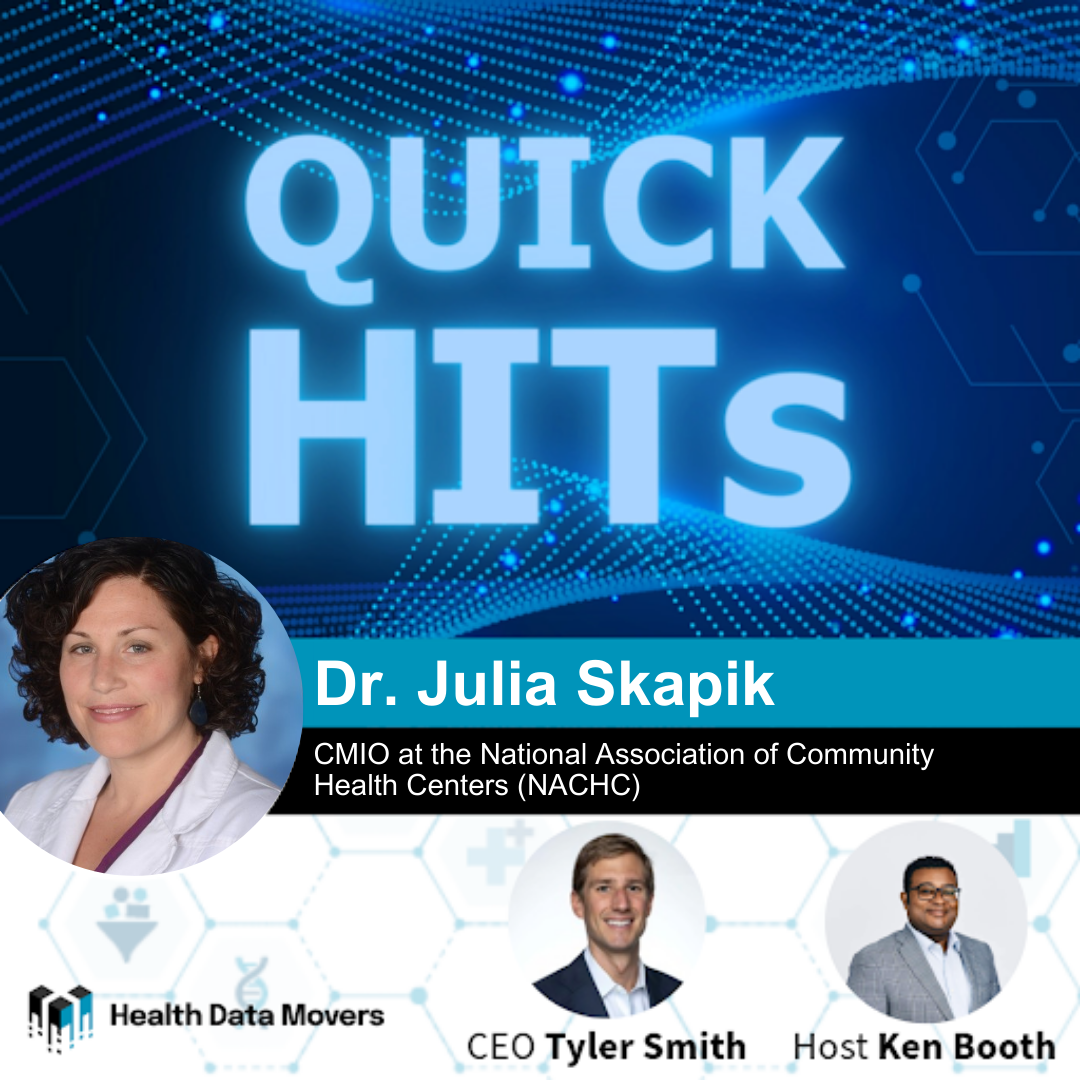Don’t have time to listen to our latest episode Advancing Health Equity through Technology: A Conversation with Dr. Julia Skapik? Find an overview of our conversation below!
Overview of Advancing Health Equity through Technology: A Conversation with Dr. Julia Skapik:
Tyler Smith: In this episode of QuickHITs, we’re thrilled to host Dr. Julia Skapik, the CMIO of the National Association of Community Health Centers and board chair for the international Board of Directors for HL7. With her extensive background as a practicing physician and her expertise in public health policy, Dr. Skapik brings valuable insights to the table. Her career has been dedicated to integrating technology and data to address social determinants of health, aiming to bridge gaps in care and promote equity across healthcare systems.
Ken Booth: Welcome to another episode of QuickHITs. I’m your host, Ken Booth, joined as always by Tyler Smith. Tyler, how are you?
Tyler Smith: Excited to be here, Ken.
Ken Booth: Me too. We’ve got a great guest this episode, Dr. Julia Skapik. Dr. Skapik, welcome to the show.
Dr. Skapik: Thank you so much for having me.
Ken Booth: Could you start by giving us a rundown of your background?
Dr. Skapik: Sure. I’m a physician in clinical informatics and the CMIO with the National Association of Community Health Centers. I do a lot of public health research and quality improvement work in community health centers around the country, supporting their technology and data applications. I’m also the chair of the board of HL7 International, focusing on standards development and advocacy in health information technology.
Ken Booth: What initially attracted you to healthcare IT?
Dr. Skapik: As a medical student, I was interested in the problem of medical errors and quality. I see technology and data as systems problems that need to be tackled with a focus on human-centered design and usability. We need to make sure technology and data support the care team and patient rather than create barriers.
Ken Booth: How does your work intersect with health equity?
Dr. Skapik: Technology can either exacerbate inequity or drive improvements. We can make services more accessible, use more languages, and visualize information better. However, the way we’ve been doing it often makes problems worse by not meeting patient and user needs effectively.
Ken Booth: What trends are you seeing that lead to provider burnout and inequity?
Dr. Skapik: Many care team members feel like glorified data entry clerks. They perceive a lot of the information they enter is never used, which takes time away from patient care. We need to focus on AI-enabled documentation to ease these burdens.
Ken Booth: Do community health centers have access to the latest technology?
Dr. Skapik: It’s challenging. Health centers work on small margins and often lack the resources for infrastructure and ongoing costs. They might have a lag of 3-5 years in adopting new technology, impacting their ability to provide value to patients.
Tyler Smith: You’ve seen a lot in your career, from the ONC days to now. What stands out to you in terms of technology adoption?
Dr. Skapik: We’re at an exciting point where we’ve laid the groundwork for a future that looks more like smartphones and the web. However, not much has changed from a user perspective in the last 10-20 years. We need to rethink how we visualize and engage with information to make it more patient-centered.
Tyler Smith: How do you bring the physician’s lens to your work with HL7?
Dr. Skapik: HL7 is an International Standard Development Organization that focuses on consensus-based standards building. We aim to ensure all voices, including clinicians and patients, are represented in our work. We’re working on Fire Accelerators and other projects to develop standards informed by real-world use.
Ken Booth: With AI becoming more prevalent, how do you ensure it benefits healthcare?
Dr. Skapik: We need to ensure AI improves usability and workflow. AI should be designed with input from all stakeholders, including those focused on health equity. HL7’s AI task force is working on standards to guide the development and use of AI in healthcare.
Tyler Smith: What’s your vision for the future of FQHCs and AI?
Dr. Skapik: FQHCs have been addressing social needs for decades. They should be involved in designing and testing new tools. For AI, we need to ensure it’s used safely and effectively, with a focus on improving usability and reducing workload for healthcare providers.
Ken Booth: Dr. Skapik, thank you for sharing your insights. It’s been a pleasure.
Dr. Skapik: Thank you for having me.
Tyler Smith: Thanks for tuning in to QuickHITs. Until next time, stay informed and stay healthy.
Want to hear the full episode? Listen Here: Advancing Health Equity through Technology: A Conversation with Dr. Julia Skapik

